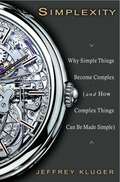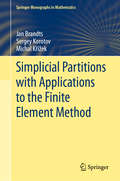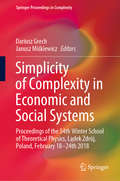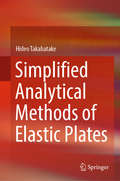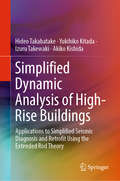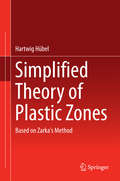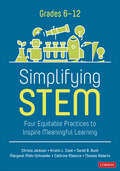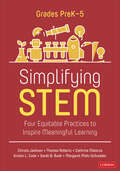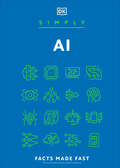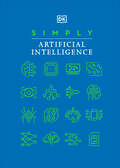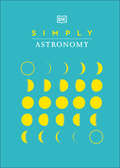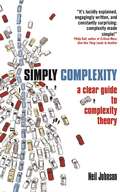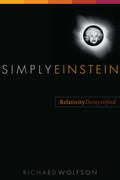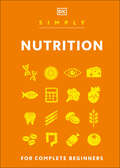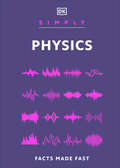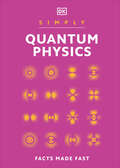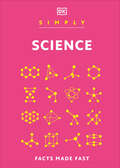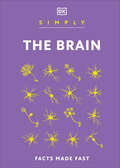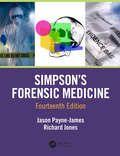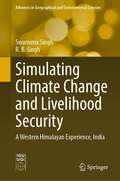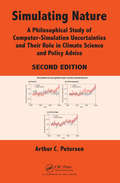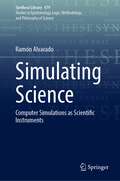- Table View
- List View
Simplexity: Why Simple Things Become Complex (and How Complex Things Can Be Made Simple)
by Jeffrey KlugerWhy are the instruction manuals for cell phones incomprehensible? Why is a truck driver's job as hard as a CEO's? How can 10 percent of every medical dollar cure 90 percent of the world's disease? Why do bad teams win so many games?Complexity, as any scientist will tell you, is a slippery idea. Things that seem complicated can be astoundingly simple; things that seem simple can be dizzyingly complex. A houseplant may be more intricate than a manufacturing plant. A colony of garden ants may be more complicated than a community of people. A sentence may be richer than a book, a couplet more complicated than a song.These and other paradoxes are driving a whole new science--simplexity--that is redefining how we look at the world and using that new view to improve our lives in fields as diverse as economics, biology, cosmology, chemistry, psychology, politics, child development, the arts, and more. Seen through the lens of this surprising new science, the world becomes a delicate place filled with predictable patterns--patterns we often fail to see as we're time and again fooled by our instincts, by our fear, by the size of things, and even by their beauty.In Simplexity, Time senior writer Jeffrey Kluger shows how a drinking straw can save thousands of lives; how a million cars can be on the streets but just a few hundred of them can lead to gridlock; how investors behave like atoms; how arithmetic governs abstract art and physics drives jazz; why swatting a TV indeed makes it work better. As simplexity moves from the research lab into popular consciousness it will challenge our models for modern living. Jeffrey Kluger adeptly translates newly evolving theory into a delightful theory of everything that will have you rethinking the rules of business, family, art--your world.ve thousands of lives; how a million cars can be on the streets but just a few hundred of them can lead to gridlock; how investors behave like atoms; how arithmetic governs abstract art and physics drives jazz; why swatting a TV indeed makes it work better. As simplexity moves from the research lab into popular consciousness it will challenge our models for modern living. Jeffrey Kluger adeptly translates newly evolving theory into a delightful theory of everything that will have you rethinking the rules of business, family, art--your world.
Simplicial Partitions with Applications to the Finite Element Method (Springer Monographs in Mathematics)
by Jan Brandts Sergey Korotov Michal KřížekThis monograph focuses on the mathematical and numerical analysis of simplicial partitions and the finite element method. This active area of research has become an essential part of physics and engineering, for example in the study of problems involving heat conduction, linear elasticity, semiconductors, Maxwell's equations, Einstein's equations and magnetic and gravitational fields.These problems require the simulation of various phenomena and physical fields over complicated structures in three (and higher) dimensions. Since not all structures can be decomposed into simpler objects like d-dimensional rectangular blocks, simplicial partitions are important. In this book an emphasis is placed on angle conditions guaranteeing the convergence of the finite element method for elliptic PDEs with given boundary conditions. It is aimed at a general mathematical audience who is assumed to be familiar with only a few basic results from linear algebra, geometry, and mathematical and numerical analysis.
Simplicity of Complexity in Economic and Social Systems: Proceedings of the 54th Winter School of Theoretical Physics, Lądek Zdrój, Poland, February 18–24th 2018 (Springer Proceedings in Complexity)
by Dariusz Grech Janusz MiśkiewiczThis book presents the Proceedings of the 54th Winter School of Theoretical Physics on Simplicity of Complexity in Economic and Social Systems, held in Lądek Zdrój, Poland, from 18 to 24 February 2018. The purpose of the book is to introduce the new interdisciplinary research that links statistical physics, and particular attention is given to link physics of complex systems, with financial analysis and sociology. The main tools used in these areas are numerical simulation of agents behavior and the interpretation of results with the help of complexity methods, therefore a background in statistical physics and in physics of phase transition is necessary to take the first steps towards these research fields called econophysics and sociophysics. In this perspective, the book is intended to graduated students and young researchers who want to begin the study of this established new area, which connects physicists, economists, sociologists and IT professionals, to better understand complexity phenomena existing not only in physics but also in complex systems being seemingly far from traditional view at physics.
Simplified Analytical Methods of Elastic Plates
by Hideo TakabatakeThis book presents simplified analytical methodologies for static and dynamic problems concerning various elastic thin plates in the bending state and the potential effects of dead loads on static and dynamic behaviors. The plates considered vary in terms of the plane (e.g. rectangular or circular plane), stiffness of bending, transverse shear and mass. The representative examples include void slabs, plates stiffened with beams, stepped thickness plates, cellular plates and floating plates, in addition to normal plates. The closed-form approximate solutions are presented in connection with a groundbreaking methodology that can easily accommodate discontinuous variations in stiffness and mass with continuous function as for a distribution. The closed-form solutions can be used to determine the size of structural members in the preliminary design stages, and to predict potential problems with building slabs intended for human beings’ practical use.
Simplified Dynamic Analysis of High-Rise Buildings: Applications to Simplified Seismic Diagnosis and Retrofit Using the Extended Rod Theory
by Izuru Takewaki Hideo Takabatake Yukihiko Kitada Akiko KishidaThis book presents a simple analytical method based on the extended rod theory that allows the earthquake resistance of high-rise buildings to be easily and accurately evaluated at the preliminary design stage. It also includes practical software for applying the extended rod theory to the dynamic analysis of actual buildings and structures. High-rise buildings in large cities, built on soft ground consisting of sedimentary rock, tend to have low natural frequency. If ground motion due to an earthquake occurs at distant hypocenters, the vibration wave can be propagated through several sedimentary layers and act on skyscrapers as a long-period ground motion, potentially producing a resonance phenomenon that can cause severe damage. Accordingly, there is a pressing need to gauge the earthquake resistance of existing skyscrapers and to improve their seismic performance. This book was written by authors who have extensive experience in tall-building seismic design in Japan. The software included enables readers to perform dynamic calculations of skyscrapers’ resistance to vibrations. As such, it offers a valuable resource for practitioners and engineers, as well as students of civil engineering.
Simplified Theory of Plastic Zones
by Hartwig HübelThe present book provides a new method to estimate elastic plastic. It presents deformation via a seriesof a number of linear elastic analyses. For a life prediction ofstructures subjected to variable loads, frequently encountered in mechanicaland civil engineering, the cyclically accumulated deformation and the elasticplastic strain ranges are required. The Simplified Theory of Plastic Zones(STPZ) is a direct method which provides the estimates of these and all othermechanical quantities in the state of elastic and plastic shakedown. The STPZis described in detail, with emphasis on the fact that not only scientists butengineers working in applied fields and advanced students are able toget an idea of the possibilities and limitations of the STPZ. Numerousillustrations and examples are provided to support the reader's understanding.
Simplifying STEM [6-12]: Four Equitable Practices to Inspire Meaningful Learning (Corwin Mathematics Series)
by Sarah B. Bush Kristin L. Cook Margaret J. Mohr-Schroeder Christa Jackson Oliver Roberts Cathrine MaiorcaStart, focus, or extend your integrated STEM education journey with an authentic interdisciplinary perspective! In response to calls for active STEM learning that builds students’ agency and sense of belonging, teachers and leaders are being encouraged more and more to equitably implement integrated STEM instruction. This practical guidebook is designed to help educators create integrated STEM learning experiences that are inclusive for all students and allows them to experience STEM as scientists, innovators, mathematicians, creators, engineers, and technology experts! Addressing the STEM status quo and promoting inclusiveness in STEM fields, the authors center their work around the Equity-Oriented Conceptual Framework for STEM Literacy, which provides high-quality integrated strategies to connect students′ lived experiences to STEM learning. Simplifying STEM provides a ground-breaking model of the four Integrated STEM Practices (ISPs) to ensure coherent and aligned teaching across disciplines through authentic opportunities to meaningfully engage students. Learn how to simplify STEM with these four equitable practices to inspire deep learning Use critical and creative thinking to seek solutions Collaborate and use appropriate tools to engage in iterative design Communicate solutions based on evidence and data Recognize and use structures in real-world systems Including a STEM planning guide as well as instructional strategies and assessments for standard alignment, this is an essential resource for any educator seeking to empower their students with meaningful STEM learning experiences. The book includes an online implementation toolkit to give educators opportunities for powerful professional development built on collaboration and connection.
Simplifying STEM [6-12]: Four Equitable Practices to Inspire Meaningful Learning (Corwin Mathematics Series)
by Sarah B. Bush Kristin L. Cook Margaret J. Mohr-Schroeder Christa Jackson Oliver Roberts Cathrine MaiorcaStart, focus, or extend your integrated STEM education journey with an authentic interdisciplinary perspective! In response to calls for active STEM learning that builds students’ agency and sense of belonging, teachers and leaders are being encouraged more and more to equitably implement integrated STEM instruction. This practical guidebook is designed to help educators create integrated STEM learning experiences that are inclusive for all students and allows them to experience STEM as scientists, innovators, mathematicians, creators, engineers, and technology experts! Addressing the STEM status quo and promoting inclusiveness in STEM fields, the authors center their work around the Equity-Oriented Conceptual Framework for STEM Literacy, which provides high-quality integrated strategies to connect students′ lived experiences to STEM learning. Simplifying STEM provides a ground-breaking model of the four Integrated STEM Practices (ISPs) to ensure coherent and aligned teaching across disciplines through authentic opportunities to meaningfully engage students. Learn how to simplify STEM with these four equitable practices to inspire deep learning Use critical and creative thinking to seek solutions Collaborate and use appropriate tools to engage in iterative design Communicate solutions based on evidence and data Recognize and use structures in real-world systems Including a STEM planning guide as well as instructional strategies and assessments for standard alignment, this is an essential resource for any educator seeking to empower their students with meaningful STEM learning experiences. The book includes an online implementation toolkit to give educators opportunities for powerful professional development built on collaboration and connection.
Simplifying STEM [PreK-5]: Four Equitable Practices to Inspire Meaningful Learning (Corwin Mathematics Series)
by Sarah B. Bush Kristin L. Cook Margaret J. Mohr-Schroeder Christa Jackson Oliver Roberts Cathrine MaiorcaStart, focus, or extend your integrated STEM education journey with an authentic interdisciplinary perspective! In response to calls for active STEM learning that builds students’ agency and sense of belonging, teachers and leaders are being encouraged more and more to equitably implement integrated STEM instruction. This practical guidebook is designed to help educators create integrated STEM learning experiences that are inclusive for all students and allows them to experience STEM as scientists, innovators, mathematicians, creators, engineers, and technology experts! Addressing the STEM status quo and promoting inclusiveness in STEM fields, the authors center their work around the Equity-Oriented Conceptual Framework for STEM Literacy, which provides high-quality integrated strategies to connect students′ lived experiences to STEM learning. Simplifying STEM provides a ground-breaking model of the four Integrated STEM Practices (ISPs) to ensure coherent and aligned teaching across disciplines through authentic opportunities to meaningfully engage students. Learn how to simplify STEM with these four equitable practices to inspire deep learning Use critical and creative thinking to seek solutions Collaborate and use appropriate tools to engage in iterative design Communicate solutions based on evidence and data Recognize and use structures in real-world systems Including a STEM planning guide as well as instructional strategies and assessments for standard alignment, this is an essential resource for any educator seeking to empower their students with meaningful STEM learning experiences. The book includes an online implementation toolkit to give educators opportunities for powerful professional development built on collaboration and connection.
Simplifying STEM [PreK-5]: Four Equitable Practices to Inspire Meaningful Learning (Corwin Mathematics Series)
by Sarah B. Bush Kristin L. Cook Margaret J. Mohr-Schroeder Christa Jackson Oliver Roberts Cathrine MaiorcaStart, focus, or extend your integrated STEM education journey with an authentic interdisciplinary perspective! In response to calls for active STEM learning that builds students’ agency and sense of belonging, teachers and leaders are being encouraged more and more to equitably implement integrated STEM instruction. This practical guidebook is designed to help educators create integrated STEM learning experiences that are inclusive for all students and allows them to experience STEM as scientists, innovators, mathematicians, creators, engineers, and technology experts! Addressing the STEM status quo and promoting inclusiveness in STEM fields, the authors center their work around the Equity-Oriented Conceptual Framework for STEM Literacy, which provides high-quality integrated strategies to connect students′ lived experiences to STEM learning. Simplifying STEM provides a ground-breaking model of the four Integrated STEM Practices (ISPs) to ensure coherent and aligned teaching across disciplines through authentic opportunities to meaningfully engage students. Learn how to simplify STEM with these four equitable practices to inspire deep learning Use critical and creative thinking to seek solutions Collaborate and use appropriate tools to engage in iterative design Communicate solutions based on evidence and data Recognize and use structures in real-world systems Including a STEM planning guide as well as instructional strategies and assessments for standard alignment, this is an essential resource for any educator seeking to empower their students with meaningful STEM learning experiences. The book includes an online implementation toolkit to give educators opportunities for powerful professional development built on collaboration and connection.
Simply AI (DK Simply)
by DKUnderstanding AI has never been easier.Combining bold graphics with easy-to-understand text, Simply Artificial Intelligence is the perfect introduction to the world of AI for those who are short of time but hungry for knowledge.Covering a broad range of fields within AI – from computing and mathematics to politics and philosophy – entries demystify what artificial intelligence is and how it works, how it has dramatically changed the way we live, and how it might evolve in the future.Explaining each individual aspect of AI more clearly than ever before, the book outlines the key building-blocks and technological milestones in its history, profiles its most important practical applications – both currentand predicted – and explores the numerous ethical debates around AI, and its increasing influence on culture and society.Whether you are studying science or AI-related subjects at school or college, or simply want a jargon-free overview of this increasingly important subject, this essential guide is packed with everything you need to understand the basics quickly and easily.
Simply Artificial Intelligence (DK Simply)
by DKUnderstanding AI has never been easier with Simply Artificial Intelligence. Combining bold graphics with easy-to-understand text, Simply Artificial Intelligence is the perfect introduction to the world of AI for those who are short of time but hungry for knowledge.Covering a broad range of fields within AI – from computing and mathematics to politics and philosophy – entries demystify what artificial intelligence is and how it works, how it has dramatically changed the way we live, and how it might evolve in the future.Explaining each individual aspect of AI more clearly than ever before, the book outlines the key building-blocks and technological milestones in its history, profiles its most important practical applications – both current and predicted – and explores the numerous ethical debates around AI, and its increasing influence on culture and society. Dive deep into this book to further discover: - Clear graphics and simple definitions make this complex and increasingly important subject easier to grasp than ever before.- Entries cover a broad range of relevant subject areas – from computing and mathematics to philosophy and politics – exploring and explaining each one in a super-simple way.-Easy-to-understand graphics help to explain over 120 concepts, applications, and theories in a clear, visual way.Whether you are studying science or AI-related subjects at school or college, or simply want a jargon-free overview of this increasingly important subject, this essential guide is packed with everything you need to understand the basics quickly and easily. Perfect for complete beginners and time-poor readers looking for a quick overview of AI.At DK, we believe in the power of discovery. So why stop there? If you like Simply AI then why not complete the collection and try the other books in DK&’s wonderful Simply series? Explore the inner workings of the brain like never before with Simply Brain, start asking deeper questions with Simply Philosophy or soar into space with Simply Astronomy.
Simply Astronomy (DK Simply)
by DKThe simplest guide to astronomy and stargazing!Grasping astronomy has never been easier. Your awe of the night sky will soon turn into knowledge of the constellations, planets and astrological phenomena!Bold graphics and easy-to-understand text make this visual guide the perfect introduction to astronomy and stargazing for those who have little time but a big thirst for knowledge. Inside, you&’ll find: • Simple, easy-to-understand graphics that help to explain astronomy, space and the night sky in a clear, visual way. • The latest astronomical information on black holes, gravitational waves, the origin of the universe and the planets of the Solar System. • User-friendly star-charts that guide you through the sky using brighter stars as &“signposts&” to locate harder-to-see objects. • Essential advice on the practicalities of stargazing — from observing with the naked eye to using telescopes. Each pared-back entry covers the essentials more clearly than ever before. The opening chapters provide an introduction to the universe, a visual tour of the Solar System and a guide to more distant objects such as stars and galaxies. Along the way, concepts such as the Big Bang, gravity and space-time are introduced and explained. Later chapters describe how to navigate around the night sky and introduce somemust-see constellations, complete with simple star charts.Whether you are a complete beginner, or simply want a jargon-free reference to astronomy and stargazing, this essential guide is packed with everything you need to understand the basics quickly and easily.
Simply Complexity: A Clear Guide to Complexity Theory
by Neil JohnsonWhat do traffic jams, stock market crashes, and wars have in common? They are all explained using complexity, an unsolved puzzle that many researchers believe is the key to predicting - and ultimately solving-everything from terrorist attacks and pandemic viruses right down to rush hour traffic congestion.Complexity is considered by many to be the single most important scientific development since general relativity and it promises to make sense of no less than the very heart of the Universe. Using it, scientists can find order emerging from seemingly random interactions of all kinds, from something as simple as flipping coins through to more challenging problems such as the patterns in modern jazz, the growth of cancer tumours, and predicting shopping habits.
Simply Einstein: Relativity Demystified
by Richard WolfsonCareful but simplified scientific explanation.
Simply Einstein: Relativity Demystified
by Richard WolfsonWith this reader-friendly book, it doesn't take an Einstein to understand the theory of relativity and its remarkable consequences. In clear, understandable terms, physicist Richard Wolfson explores the ideas at the heart of relativity and shows how they lead to such seeming absurdities as time travel, curved space, black holes, and new meaning for the idea of past and future. Drawing from years of teaching modern physics to nonscientists, Wolfson explains in a lively, conversational style the simple principles underlying Einstein's theory. Relativity, Wolfson shows, gave us a new view of space and time, opening the door to questions about their flexible nature: Is the universe finite or infinite? Will it expand forever or eventually collapse in a "big crunch"? Is time travel possible? What goes on inside a black hole? How does gravity really work? These questions at the forefront of twenty-first-century physics are all rooted in the profound and sweeping vision of Albert Einstein's early twentieth-century theory. Wolfson leads his readers on an intellectual journey that culminates in a universe made almost unimaginably rich by the principles that Einstein first discovered.
Simply Nutrition (DK Simply)
by DKUnderstanding nutrition has never been easier.Combining bold graphics with easy-to-understand text, Simply Nutrition is the perfect introduction for those who are short of time but hungry for knowledge.Covering a range of topics – from a healthy gut and the essential function of vitamins and minerals, to the pros and cons of plant-based diets, and the reasons why highly processed foods tend to be less good for us – each entry provides a clear and simple explanation of all of the key aspects of nutrition. Organized thematically, and enriched with eye-catching infographics, the book draws on the latest research in the field, providing a reliable and up-to-date point of entry into the subject. Dive straight into this helpful health book to explore: -Clear graphics and simple definitions which make the subject easier to grasp than ever before. -Entries that cover a broad range of areas within nutrition – from food groups to the science behind the best-known diets – exploring and explaining each one in an accessible way.-The perfect introduction for complete beginners and time-poor readers looking for a quick overview.-Mind-blowing facts dispel myths and misconceptions about healthy eating and nutrition.-Simple, easy-to-understand graphics help to explain key concepts in a clear, visual wayWhether you are studying nutrition at school or college, want to better understand how different diets work, or are looking for a jargon-free overview of the subject, this essential guide is packed with everything you need to understand the basics quickly and easily.
Simply Physics (DK Simply)
by DKCombining simple, stylish graphics with easy-to-understand text, Simply Physics is the perfect introduction to the subject for those who are short of time but hungry for knowledge.Compact and clear, this book covers the core concepts of physics in a refreshing and highly accessible way – from gravitational fields and momentum to general relativity and the mysteries of quantum uncertainty. Using simple diagrams and directly worded explanations, each pared-back entry explains concepts more clearly and concisely than ever before.Whether you are studying physics at school or college, or simply want a jargon-free insight into what physics is all about, this essential guide gives you shortcuts and beelines to knowledge that will make you cry, "At last! I understand!"
Simply Quantum Physics (DK Simply)
by DKA clear, simple, graphic-led introduction to quantum physics.Are you short of time but hungry for knowledge? This beginner&’s quantum physics book proves that sometimes less is more. Bold graphics and easy-to-understand explanations make it the most accessible guide to quantum physics on the market.This smart but powerful guide cuts through the jargon and gives you the facts in a clear, visual way. Step inside the strange and fascinating world of subatomic physics that at times seems to conflict with common sense. Unlock the mysteries of more than 100 key ideas, from quantum mechanics basics to the uncertainty principle and quantum tunneling.Each pared-back, single-page entry demystifies the groundbreaking ideas in modern science. From Schrödinger&’s Cat and quantum teleportation to atoms and gravity, Simply Quantum Physics is the ultimate jargon-free overview of the subject. Understanding Quantum Physics Has Never Been EasierThis illuminating reference book introduces you to the greatest physicists of the 20th and 21st centuries, such as Albert Einstein, Neils Bohr, Erwin Schrödinger, Richard Feynman, and more! It&’s the perfect gift for anyone interested in physics or science in general and life-long learners. Whether you&’re a physics student or just an interested layman, this indispensable guide is packed with everything you need to quickly and easily understand the basics.Complete the Series:Part of DK Book's exciting, brand-new reference series for those who are time-poor but keen to learn more. Discover the mysteries of more key philosophical ideas in Simply Philosophy.
Simply Science (DK Simply)
by DKUnderstanding science has never been easier.Combining bold graphics with easy-to-understand text, Simply Science is the perfect introduction for those who are short on time but hungry for knowledge.The book covers not only the core sciences—physics, biology, and chemistry—but also Earth science and astronomy. Assuming no previous scientific knowledge, it covers more than 100 cornerstone ideas, ranging from photosynthesis to chemical reactions, the laws of motion, and the general theory of relativity. Pared-back entries each focus on a single concept and use a combination of clear text and simple graphics to explain it as directly and concisely as possible.Whether you are studying science in school or college, or simply want a jargon-free overview of the subject, this essential guide is packed with everything you need to understand the basics of science quickly and easily.
Simply The Brain (DK Simply)
by DKThe human brain is a most remarkable organ, but how well do we really understand the way it works?What is a brain and what is the mind? Do you only use 10% of your brain? Why do some people hear colour? If you find yourself seeking the answers to these questions and many more, then Simply The Brain may be the book for you!Simply The Brain explores everything that goes on in the brain when you think, feel, and perceive the world around you. If you&’re seeking a guide that breaks down the inner workings of the mind and the brain, in a way that is easy to understand and jargon-free, then this essential guide is packed with everything you need to understand the basics quickly and easily. Covering more than 90 key ideas from neurons and nerves to forming memories and brain implants, each pared-back entry explains the concept more clearly than ever before.Dive straight in to discover: Simple, easy-to-understand graphics help to explain more than 90 key conceptsCovers all aspects the brain to give a brief overview of this complex subjectConcise explanations quickly convey the most important informationCombining bold, elegant graphics with easy-to-understand text, Simply The Brain is the perfect introduction to the subject for those who are short of time but hungry for knowledge, so if you&’re interested in neuroscience or curious about how the mind works - then this is the book for you!
Simpson's Forensic Medicine, 14th Edition
by Jason Payne-James and Richard JonesPrestigious and authoritative, this fully updated fourteenth edition of Simpson's Forensic Medicine remains a classic; one of the world's leading introductory texts in the field of forensic medicine. It presents all that the generalist or student needs to know about the interface between medicine and the law.
Simulating Climate Change and Livelihood Security: A Western Himalayan Experience, India (Advances in Geographical and Environmental Sciences)
by R. B. Singh Swarnima SinghThis book identifies and provides reasoning for computed methods of local climate dynamics and the livelihood vulnerability indices assessment in the mountainous region of Himachal Pradesh, India. The outcomes of this study agree with the focused objectives on simulating climate change and its impact on livelihood security. It deals with several crucial methodologies to analyze livelihood security with and without climate change. The explorative deductive approach was used to observe climatic changes since the 1970s and simulated the climate until 2080. Additionally, the composite livelihood vulnerability index (LVI) without climate change and the climate change livelihood vulnerability index (CCLVI) with climate change impact were prepared. The book is beneficial for policymakers who are involved in framing and implementing policies chiefly in the Himalaya. It is also valuable for all stakeholders in society: students, researchers and academicians. It proposes discussions and debate on a new, integrated, inclusive and open approach to climate change and validates the significance of geographic knowledge in addressing climate change issues at various levels, suggesting policy measures to cope with them.
Simulating Nature: A Philosophical Study of Computer-Simulation Uncertainties and Their Role in Climate Science and Policy Advice, Second Edition
by Arthur C. PetersenComputer simulation has become an important means for obtaining knowledge about nature. The practice of scientific simulation and the frequent use of uncertain simulation results in public policy raise a wide range of philosophical questions. Most prominently highlighted is the field of anthropogenic climate change-are humans currently changing the
Simulating Science: Computer Simulations as Scientific Instruments (Synthese Library #479)
by Ramón AlvaradoThis book provides a philosophical framework to understand computer simulations as scientific instruments. This is in sharp contrast to existing philosophical approaches on the subject, which have historically understood computer simulations as either formal abstractions or as broadly construed empirical practices. In order to make its case, the volume contains a thorough examination of conventional philosophical approaches as well as their respective limitations. Yet, also, unlike other accounts of computer simulations from the perspective of the philosophy of science, this book incorporates insights from the philosophy of technology and the history of science. Hence, the book offers philosophers of science, technologists and other researchers interested in the topic, a thorough overview of the philosophical issues regarding the design, development and deployment of computer simulations in science and science-based policy making.
